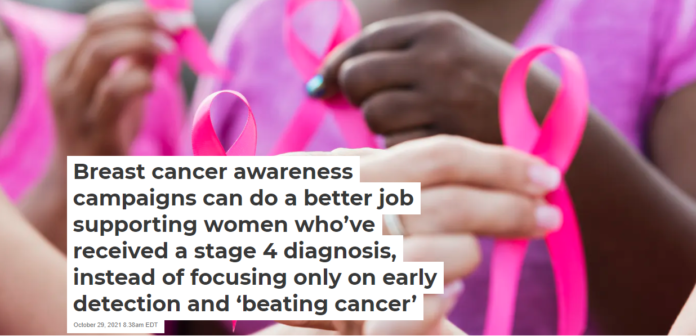

Rachel Kraus, Ball State University
Since 1985, cancer-related nonprofits, along with pharmaceutical firms and other businesses, have sponsored an international campaign to observe October as “Breast Cancer Awareness Month.” During these weeks, the public is bombarded with public health messages featuring the campaign’s symbol, a pink ribbon.
A wave of pink products typically appears, too, including clothing – think about the “Save the Ta-Tas” shirts – as well as events like marches and walkathons. This onslaught has led some to term the campaign “Pinktober.”
These efforts often focus on encouraging women to get screened with mammograms to increase the possibility that the cancer will be detected early. Breast cancer patients are celebrated for “beating” cancer, “winning” the battle, having survived and being cured. But these messages overlook the experiences of millions of breast cancer patients.
I am a sociology professor who specializes in studying gender identity as well as how having a serious illness affects identity. These themes also hit close to home for me: I was diagnosed with metastatic breast cancer in 2009 – also referred to as stage 4 on a scale from 0 to 4 – which means a cancer that has spread beyond the breasts to other parts of the body. Since that time, I have participated in face-to-face and online support groups, joined retreats and met myriad health professionals who specialize in oncology while also continuing my research.
In 2019, I began a nationwide study to examine the experiences of women with stage 4 breast cancer. The first of my papers on religion’s role in coping with metastatic breast cancer will be published in the Journal for the Scientific Study of Religion. I am now working on research that examines metastatic breast cancer and identity.
The seriousness of metastatic breast cancer, which is the only breast cancer that kills, is rarely discussed. This leaves people with this diagnosis feeling ignored and angry – and largely invisible to most of the organizations focused on breast cancer.
A need for inclusion
Breast cancer is nearly the most common cancer in women in the United States, second only to skin cancer. One in 8 American women will be diagnosed with breast cancer at some point in her life. Although women of color are less likely to get breast cancer, they are more likely to die from it. Male breast cancer makes up less than 1% of all cases of breast cancer.
Nearly 30% of people with early stages of breast cancer will see their cancer metastasize to stage 4, which kills about 44,000 American women and men each year.
To find participants with stage 4 breast cancer for my survey, I sent out requests through online support groups, cancer organizations and societies, and word of mouth. Ultimately 310 women completed a questionnaire about their experiences with metastatic breast cancer, such as perceived support, feelings about breast cancer organizations and the pink ribbon, and ways of coping.
I selected 33 of those women to participate in in-depth interviews to provide additional information about some of their survey answers.

Kevin C. Cox/Getty Images Sport via Getty Images North America
According to my research, these patients generally do not feel like they fit the “survivor” mantra associated with pictures often seen in the media of women who are cured of breast cancer, happy and getting on with their lives.
Further, many of these women do not believe that breast cancer organizations, including pink ribbon groups, do a good job of including metastatic patients in their campaigns. They feel like they are left out of public discussions on breast cancer and that little is being done to showcase the less optimistic and more frightening aspects of metastatic disease.
Asking women to rate their preferences on a scale of 1 to 4, from “not at all” to “a great deal,” I found that more metastatic people prefer the term “patient” – which scored an average of 3.1 – and “a person who has cancer” – which scored a 3.3 – rather the term “survivor,” which rated an average of 2.3.
On average, many participants also say there isn’t much recognition that those with metastatic disease may face somewhat different treatment outcomes.
Often, stage 1 to 3 patients can look forward to a treatment end date. The vast majority of metastatic patients will be in treatment for the rest of their lives.
Earlier stages of breast cancer typically have more than one treatment option, including radiation, surgery – mastectomy or lumpectomy – and what are called systemic therapies, such as chemotherapy.
For stage 4 breast cancer, there is some debate as to whether lumpectomy or mastectomy are effective options. The effectiveness of radiation treatment is also debatable. So metastatic patients more typically receive chemotherapy and – more recently – immunotherapy, with no surgery.
I also learned that many stage 4 breast cancer patients find it necessary to manage the diagnosis in ways that don’t apply to those with earlier stages. Metastatic patients must go into treatment simultaneously hoping the drugs will calm the cancer and confronting potential end-of-life issues. They may worry about leaving their families. Some may set milestones, such as seeing their children or grandchildren graduate from school or get married.
They may also be contending with issues like how many possible treatment options are left, or maximizing both quantity and quality of life amid a range of side effects.
Overturning worn-out narratives
I surveyed participants about the degree to which they feel excluded from breast cancer organizations, and why. They firmly indicated feeling a recognition gap among breast cancer organizations and awareness campaigns. So many seem to emphasize early detection and survivorship, and leave out the concerns and needs of metastatic patients.
One respondent talked about the “early detection mantra.” Another referred to the “ringing of the bell,” a common celebratory ritual when one is done with treatment. I’ve been known to use the phrase “that damn bell” to express frustration that I will always be on treatment and won’t get to ring that bell.
After completing one of my several radiation therapies, a nurse harmlessly asked me if I would like to ring the bell. I thought, “There is a lot more beyond this one course of therapy” and, not knowing what to say, I simply started crying. Thankfully they had a little guardian angel pin they gave me instead.
Several organizations are starting to fill these gaps. Some are devoting themselves to funding research for breast cancer, while others are now paying more attention to stage 4 patients – or at least moving in that direction. Metavivor is one organization focused exclusively on serving the metastatic breast cancer community.
My own experiences, and that of so many others with metastatic breast cancer, make it clear that public campaigns and breast cancer organizations can do much more for these patients.
[Like what you’ve read? Want more? Sign up for The Conversation’s daily newsletter.]![]()
Rachel Kraus, Professor of Sociology, Ball State University
This article is republished from The Conversation under a Creative Commons license. Read the original article.



















